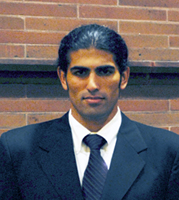(De)Vice Squad Leader
Nabeel Ahmad (Ed.D., '09, Instructional Technology and Media) believes everyone has something to learn from mobile apps
BY Siddhartha Mitter
When Nabeel Ahmad runs into a snag writing code for a mobile application, he does what many programmers do: He submits his problem to the crowd.
“I copy-paste the error, and I go to a site like Stack Overflow, where there are people having similar problems,” says Ahmad, who earned his doctorate from TC in 2009 and now returns every year as an adjunct professor. “It’s problem-based learning. You don’t necessarily care who is helping you; it’s just the nature of getting some help.”
Other tools work the same way, Ahmad says—for example, the mobile apps that museums increasingly use to help visitors get the most out of their exhibits, or the apps that teach users a language in small but effective doses, for instance by selecting and helping them through news articles on topics that interest them.
In his day job as a learning developer at IBM, Ahmad, an Oklahoma native with a background in business and computer science, creates and deploys similar learning tools that the corporation’s 450,000 employees can access on phones and tablets. His work on IBM’s mobile-learning strategy stems from his TC doctoral dissertation in Instructional Technology and Media.
“The main thing I looked at was what people use their phones for in a workplace setting,” Ahmad says. “Do they want access to learning material, and if so, what type of material?”
At IBM, he found, most intensive mobile users were “client-facing” sellers and consultants on the move. They didn’t have time for 60-minute training courses. Rather, “they’re looking for just-in-time information: something they can pull up at the time of need that will help them with the client. It’s not necessarily the first time they’re viewing this information, but they need it for quick recall.”
Problem-based learning is common among computer programmers, but it’s far from standard practice in schools. Of course, an IBM consultant making client calls has needs that differ from those of an adult language learner, a college student, or a child in elementary school. But Ahmad says that the increasingly ubiquitous tools of smartphones, handheld devices and social networking platforms offer new learning opportunities in every context.
“There are core underlying similarities from a design standpoint, from a curriculum standpoint,” he says. “No matter the setting, you have to get certain things right.” For instance, museum apps that are overly visual or text-heavy tend to backfire because they distract the visitor from the actual exhibition. Better apps, he adds, make more use of audio, which complements the visual input the visitor is receiving.
At TC, Ahmad teaches a class on mobile-phone learning (with fellow TC grad Dominic Mentor), a spin-off course on handheld devices, and another titled “Social Media & Learning” (with Tariq Ahmad). The latter is designed to appeal to students in every TC department, with potential applications that run the gamut from creating physical-education instructional videos to conducting remote, group-based therapy in real time. Ahmad guides students from the social learning and social development theories of Albert Bandura and Lev Vygotsky to the use of these theories in different learning contexts. In one lesson, a student demonstrated how an iPad app called Inkling can be used to make reading textbooks more social. (Users can see others’ notes while reading chapters, highlight sections they find useful, and follow other users, thereby creating a social learning network.) In another lesson, the class used the language-learning app Voxy to demonstrate the power of situated learning (learning that takes place in the same context in which it is to be applied).
“We learned the word for ‘green’ in Mandarin,” Ahmad says. “Then we contextualized our learning by taking a picture of something green nearby —in this case, my sweater. Then the app spoke the word ‘green’ to us and showed us the character and transliteration.”
Ahmad imports an impressive cast of guest speakers to his classroom, including scientists from IBM Learning, experts in international media development from Columbia’s School of International and Public Affairs, officials from the New York City Department of Education and entrepreneurs from technology start-ups.
Ahmad is quick to note that, as much as Facebook, Twitter and other social media tools have become part of our lives, schools often expressly ban the devices that facilitate their use. “I don’t blame them,” he says of educators leery of the distractions caused by smartphones and other gadgetry in the classroom. But, he says, such bans prevent a lot of potential learning.
He believes social tools are edging their way toward the classroom. He cites the platform Piazza, which lets students and teachers interact and collaborate, and TeacherTube, where teachers and learners share instructional videos. Apps are also sprouting up that students can use outside of school, for instance on field trips.
Ahmad says that mobile tech evangelists are a growing force in education policy at both the federal and local levels. One, Lisa Nielsen of the New York City Department of Education, who maintains a popular personal blog on education innovation, has spoken in his class.
Ahmad is optimistic that the field of education is catching up with innovative ways that people are learning in different settings. He finds his TC students eager to know what is happening in the business world, where neat-sounding innovations are put to the test. “Ideas are cheap, in a way,” he says. “It’s the execution that matters.”
Published Wednesday, May. 2, 2012
